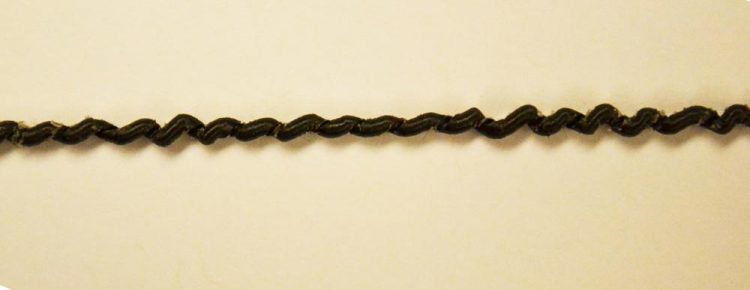Strong carbon fiber artificial muscles can lift 12,600 times their own weight

This is a zoom-in of the carbon-fiber reinforced coiled muscle with a diameter of 0.4mm. Credit: University of Illinois Department of Mechanical Science and Engineering
Some Illinois researchers working on artificial muscles are seeing results even the fittest individuals would envy, designing muscles capable of lifting up to 12,600 times their own weight.
Assistant professor of mechanical science and engineering Sameh Tawfick, Beckman postdoctoral fellow Caterina Lamuta, and Simon Messelot recently published a study on how to design super strong artificial muscles in the journal Smart Materials and Structures. The new muscles are made from carbon fiber-reinforced siloxane rubber and have a coiled geometry.
These muscles are capable of not only lifting up to 12,600 times their own weight, but also supporting up to 60 MPa of mechanical stress, providing tensile strokes higher than 25% and specific work of up to 758 J/kg. This amount is 18 times more than the specific work natural muscles are capable of producing.
When electrically actuated, the carbon fiber-based artificial muscles show excellent performance without requiring a high input voltage: the authors showed how a 0.4 mm diameter muscle bundle is able to lift half a gallon of water by 1.4 inches with only 0.172 V/cm applied voltage.
“The range of applications of these low cost and light weight artificial muscles is really wide and involves different fields such as robotics, prosthetics, orthotics, and human assistive devices,” Lamuta said. “The mathematical model we proposed is a useful design tool to tailor the performance of coiled artificial muscles according to the different applications.
Furthermore, the model provides a clear understanding of all the parameters that play an important role in the actuation mechanism, and this encourages future research works toward the development of new typologies of fiber-reinforced coiled muscles with enhanced properties.”
The artificial muscles themselves are coils comprised of commercial carbon fibers and polydimethylsiloxane (PDMS). A carbon fibers tow is initially dipped into uncured PDMS diluted with hexane and then twisted with a simple drill to create a yarn with a homogeneous shape and a constant radius. After the curing of the PDMS, the straight composite yarn is highly twisted until it is fully coiled.
“Coiled muscles were invented recently using nylon threads,” Tawfick said. “They can exert large actuation strokes, which make them incredibly useful for applications in human assistive devices: if only they could be made much stronger.”
The team set a target of transforming carbon fibers, a very strong lightweight material which is readily commercially available, into artificial muscles.
“To use carbon fibers, we had to understand the mechanism of contraction of coiled muscles. Once we uncovered the theory, we learned how to transform carbon fibers into ultra strong muscles. We simply filled carbon fiber tows with the suitable type of silicone rubber, and their performance was impressive, precisely what we had aimed for,” Tawfick said.
This study demonstrates that muscle contraction is caused by an increase in the radius of the muscle yarn due to thermal expansion or solvent absorption of the silicone filing. “The muscles flex when the silicone rubber locally pushes the fibers apart within the tow, by applying a voltage, heat or swelling by a solvent. The internal pressure exerted from the silicone rubber onto the fibers makes the tow diameter expand and uncoil causing a contraction stroke along the length.”
During the experimental characterization, a DC voltage was applied to the ends of the coil to induce the heating of the composite and in turn cause tensile actuation. The top end of the coil was fixed, while a load was attached to the bottom to create tension. The tensile stroke was captured by a movie camera, and analyzed frame by frame. Tensile actuation was also induced through swelling via liquid hexane delivered to the coiled muscle.
Can these muscles flex even more, achieving larger strokes? The close agreement between mathematical predictions and experimental realization provides confidence in answering this question. The team found that the tensile actuation of the artificial coiled muscles can be limited by the ability of the guest material (silicone) to expand – a limit imposed by the thermal degradation properties of the guest material.
This explains why muscles actuated by swelling have higher actuation strains, they are able to swell more than heat- induced muscles. The theoretical model proposed by the authors sheds light on how to design guest material which could enable muscles with an even more impressive performance.
Media Contact
All latest news from the category: Materials Sciences
Materials management deals with the research, development, manufacturing and processing of raw and industrial materials. Key aspects here are biological and medical issues, which play an increasingly important role in this field.
innovations-report offers in-depth articles related to the development and application of materials and the structure and properties of new materials.
Newest articles

A ‘language’ for ML models to predict nanopore properties
A large number of 2D materials like graphene can have nanopores – small holes formed by missing atoms through which foreign substances can pass. The properties of these nanopores dictate many…

Clinically validated, wearable ultrasound patch
… for continuous blood pressure monitoring. A team of researchers at the University of California San Diego has developed a new and improved wearable ultrasound patch for continuous and noninvasive…

A new puzzle piece for string theory research
Dr. Ksenia Fedosova from the Cluster of Excellence Mathematics Münster, along with an international research team, has proven a conjecture in string theory that physicists had proposed regarding certain equations….



